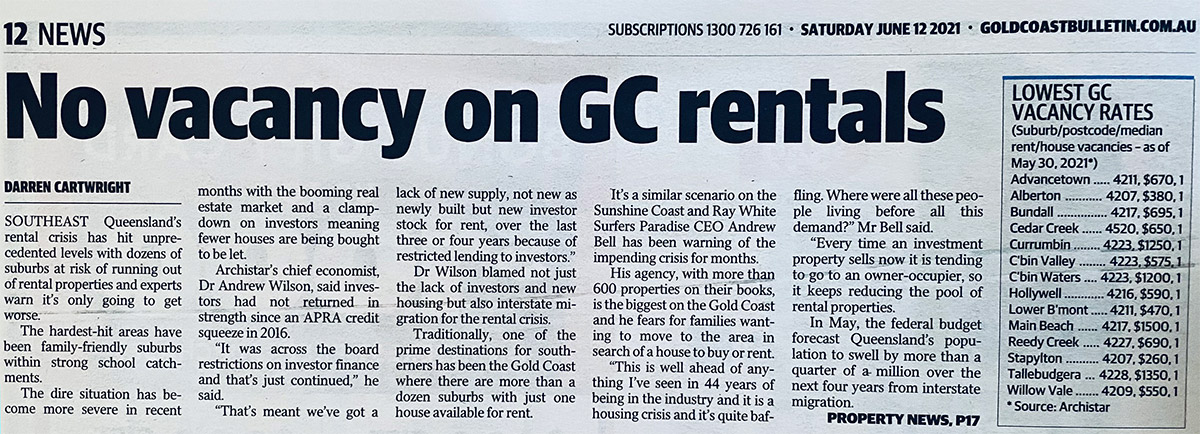How many properties sit empty?

Updated Jul 2025
Looking into the luxury high-rises in the Gold Coast suburb of Main Beach on a Sunday night recently it seemed nobody was home.
The local paper delights in announcing every new high-rise to be built, however nobody seems to be talking about the waste of having empty dwellings during a "housing crisis".

Are these figures correct?
Clearly when the lights go out tonight there will be unoccupied dwellings in Main Beach, Southport and many suburbs across Queensland.
Prices have boomed, however the real concern is investors leaving properties vacant.
Why leave an investment property vacant?
By keeping their properties free of occupants, owners gain the option of selling their investment at some point in the future and earning a higher price. Some simply do not want the issues associated with renting a property.
Holiday precincts like Surfers Paradise or Broadbeach have high numbers of investor-owned apartments that sit idle during off-peak months or are used seasonally.
Census data suggests some of these properties are effectively "ghost homes" — owned, but not used.
Victoria introduced a Vacant Residential Land Tax
Vacant residential land tax introduced 1 January 2018, applies to homes in inner and middle Melbourne that were vacant for more than six months in the preceding calendar year.
The Victorian government explain: to increase the availability of housing, the vacant residential land tax applies to empty homes in many of Melbourne's middle and inner suburbs. This tax affects you, if you own a home that is located within 16 specific council areas that has remained unoccupied for more than six months of the calendar year. The tax is charged annually, and is calculated at 1% of the property's capital improved value.
That's the value of the property, including land, buildings and other improvements. It's displayed on your council rates notice. Some vacant homes will be eligible for an exemption.
The Victorian government says it plans to enforce the tax by checking utility records to look for properties with very low usage. This tax's biggest accomplishment may be an income surge for Bunnings, as property owners buy faucet and electrical outlet timers that enable them to evade monitoring of their utility usage.
https://www.yourinvestmentpropertymag.com.au/news/the-lowdown-on-victorias-new-vacant-property-tax-234089.aspx
SEARCH ARTICLES
Recent Posts
- Jul, 22, 2025
Who is responsible for that water leak?
- May, 6, 2025
Diversity on Boards
- Apr, 11, 2025
When does asbestos become dangerous in your home?
- Jan, 23, 2025
How Design Aesthetics Shape Perceived Value
- Dec, 10, 2024
Impact of Inflation on First-Time Buyers
- Nov, 4, 2024
How to understand and check your credit score
- Sep, 19, 2024
Buying off the plan? Beware of sunset clauses
- Jul, 5, 2024
Essential Workers Explained
- Jun, 13, 2024
Ozone Generators to remove Mould
- Feb, 19, 2024
Massive tax handouts for property investors
- Feb, 16, 2024
Body Corporate sinking fund - QLD
- Feb, 2, 2024
Scaffolding Safety
- Sep, 20, 2023
Learning to Negotiate
- Jul, 11, 2023
Pension Age Rises to 67
- May, 18, 2023
Becoming A Registered Builder In Australia
- Apr, 17, 2023
Forced Sales - Queensland - 75% Rule
- Dec, 6, 2022
Petty Landlords & Negative Gearing
- Sep, 19, 2022
The benefits of shade sails for your home
- Jul, 27, 2022
Termite Swarmers Season
- Jun, 22, 2022
Fear of missing out driving inflation
- Apr, 28, 2022
Australia's Rental Crisis
- Mar, 7, 2022
Should you buy a home with Termite damage?
- Mar, 3, 2022
Tactics to reduce body corporate disputes
- Jan, 25, 2022
Globalisation - The Hedgehog & The Fox
- Nov, 2, 2021
Revealed: Top 10 areas to avoid buying
- Oct, 28, 2021
Is that house protected against termites?
- Sep, 15, 2021
Tree Changers & Sea Changers
- Aug, 12, 2021
COVID 19 and Body Corporate Responsibilities
- Jul, 29, 2021
Tenants beware of rental rewards schemes
- Jun, 25, 2021
Sunshine Coast versus Gold Coast
- Jun, 23, 2021
Your superannuation and your home
- May, 10, 2021
What Returns could I make from Property Investment
- May, 4, 2021
Real Estate Agents and Property Managers
- Apr, 20, 2021
Why You Need A Termite Inspection
- Mar, 19, 2021
SEO for Real Estate websites
- Mar, 18, 2021
Three Reasons Why Your Home Needs Data Cabling
- Mar, 16, 2021
Smoke Alarms: What you need To know in QLD
- Dec, 10, 2020
Pre-purchase Electrical Inspection
- Dec, 4, 2020
Why should I drink Adelaide Hills Wines?
- Aug, 26, 2020
Amalgamation of Strata-titled Lots for Development
- Jul, 28, 2020
Adelaide Hills a unique region
- Apr, 28, 2020
Ozone Generator in Your Home
- Apr, 21, 2020
Air conditioning cleaning
- Apr, 14, 2020
Housing Affordability in Australia
- Apr, 6, 2020
Security Systems
- Mar, 31, 2020
Termites and protecting the home
- Feb, 27, 2020
Printing for the Real Estate Industry
- Nov, 12, 2019
Beware of Property Investment Spruikers
- Oct, 31, 2019
Prices for Home Alarm Monitoring
- Oct, 9, 2019
House and Land packages best investment
- Oct, 1, 2019
The 'Scourge' of Underquoting
- Oct, 16, 2017
Professional Pest Control
- Sep, 29, 2017
Built in Wardrobes
- Jul, 9, 2015
Pool Inspections Queensland
- Jun, 25, 2015
Negotiating your purchase with the Inspection
- May, 12, 2015
DIY Move or hire a removalist company?
- Nov, 19, 2014
Why are housing prices rising faster than wages?
- Jan, 17, 2014
The Friendliest Real Estate Agents
- Jul, 23, 2013
A thorough Building and Pest Inspection
- Sep, 28, 2012
How to Compare Home Loans
- Jan, 25, 2012
Southport Real Estate

